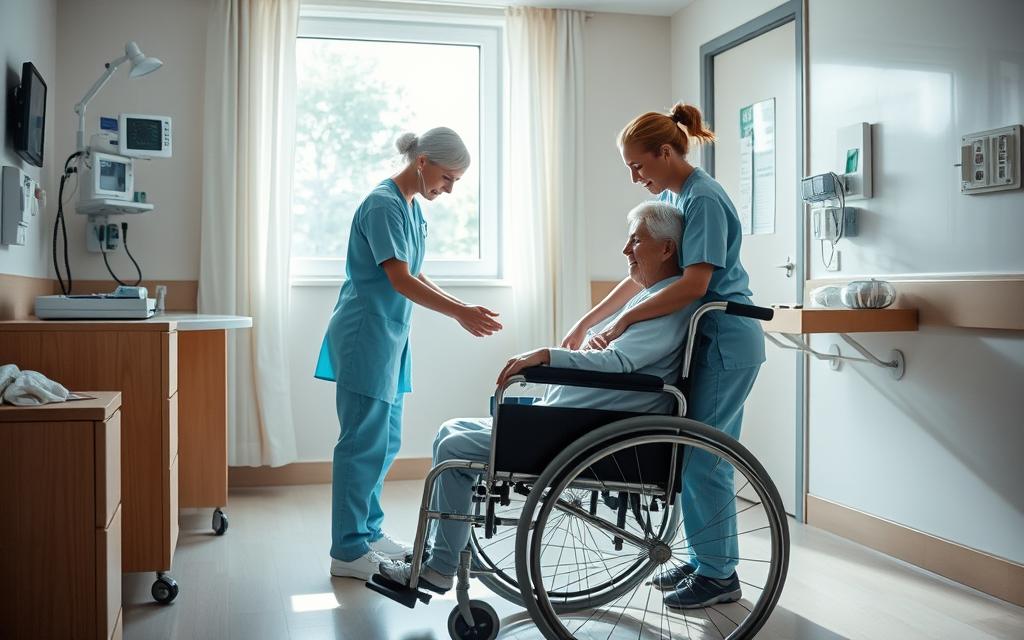Essential Roles of a Caregiver to a Patient
Caring for a patient is a big job but also very rewarding. As a caregiver, you are key to helping those in need. Your tasks can vary a lot and are important for the patient’s life quality.
Your job as a caregiver includes many tasks. These can be personal care, managing medicines, cooking meals, and driving the patient around. There are about 44 million caregivers in the U.S. over 18, which is almost one in five adults1. They add a huge value to society, with unpaid work worth $257 billion in 2000 dollars1.
Being a caregiver means more than just meeting basic needs. You might give up to 10 different medicines a day, depending on the patient’s health2. You’ll also plan meals and help with exercises. Some caregivers even cook up to three meals a day to make sure patients eat well2.
But caregiving is not easy. A recent survey showed that 76% of senior caregivers felt they weren’t ready for their job3. This shows we need better training and support for caregivers. The same survey found that 82% of caregivers feel drained physically, emotionally, and mentally3.
Key Takeaways
- Caregivers perform various tasks from emotional support to complex medical care
- There are about 44 million adult caregivers in the United States
- Caregiving duties can include medication management, meal preparation, and health monitoring
- Many caregivers feel unprepared and overwhelmed by their responsibilities
- Proper training and support are crucial for effective caregiving
Understanding the Caregiver’s Role
Caregiving is key in healthcare, covering many tasks that help patients feel better. It doesn’t matter if you’re just starting or have been doing it for years. Knowing your role is key to giving good care.
Defining a Caregiver
A caregiver helps another person, doing everything from simple companionship to complex medical tasks. They might start caring suddenly or gradually, and their job changes over time4.
Importance of Caregiving in Healthcare
Caregivers are vital in healthcare, helping with patients’ physical, emotional, and social needs. They do daily tasks like bathing, grooming, cooking, and giving medicine5. On average, they care for older adults for about 4 years, showing caregiving is a long-term job4.
Types of Caregivers
There are different kinds of caregivers, each with their own ways of caring:
- Family caregivers: Often the main caregivers for their loved ones
- Professional caregivers: Paid workers who give care
- Specialized caregivers: Focus on certain conditions like dementia or cancer
The amount of care needed depends on the person being cared for. Those caring for older adults with more needs spend about 253 hours a month on caregiving4. Good caregiving means adjusting to new needs and balancing care with life.
“Caregiving is not a one-size-fits-all role. It’s a journey that requires patience, love, and continuous learning.”
Daily Caregiving Responsibilities
Caregiving is a tough job that covers many tasks. In the U.S., family members do most of the caregiving, giving over 38 billion hours of unpaid help each year to loved ones with ongoing health issues6. These tasks are key to keeping patients healthy and happy.
Home health aides and family caregivers handle many tasks every day. They help with personal care like bathing, using the bathroom, and getting ready, which is important for seniors staying healthy at home7. They also manage nutrition, as older adults might eat less and need certain foods because of their health7.
Managing medications is a big job, especially when some patients take more than a dozen drugs7. Caregivers also help with moving people safely and preventing falls7. They do housework, drive to doctor’s visits and social events, and offer emotional support through companionship7.
| Caregiver Responsibility | Description |
|---|---|
| Personal Care | Bathing, toileting, grooming |
| Nutrition Management | Meal preparation, dietary planning |
| Medication Management | Administering medications, tracking doses |
| Mobility Assistance | Safe transfers, fall prevention |
| Emotional Support | Companionship, social interaction |
In 2009, the value of what family caregivers did for free was about $450 billion, showing how big their economic impact is6. They also keep an eye on a senior’s health, mood, and happiness, making sure to tell doctors and family about it7.
Personal Care and Hygiene Assistance
Personal care and hygiene help are key in caring for the elderly. Home health aides are crucial in keeping their patients’ dignity and well-being. With 1 in 5 Americans caring for a family member, the need for skilled caregivers is rising8.
Bathing and Grooming
Caregivers help with important hygiene tasks like bathing, shampooing, and oral care9. Safety is a top concern during these tasks. Using non-skid mats and keeping the room warm is important9. Caregivers should check the water temperature and use shower stools for comfort9.
Dressing Assistance
Helping patients get dressed is a daily task. Caregivers pick out clothes, help with putting them on, and make sure patients are comfy. On average, caregivers spend 19 days a month doing these tasks10.
Toileting and Incontinence Care
Toileting and incontinence care need patience and skill. Caregivers must keep things clean to prevent infections. They also focus on skin care to avoid pressure ulcers. For nail care, they wash hands and feet, cut nails straight, and clean tools with alcohol9.
“Personal care is not just about hygiene; it’s about preserving dignity and enhancing quality of life.”
Caregivers gain from ongoing education and support. Programs like Hope’s Family Caregiver Education Series offer valuable training9. This training helps caregivers give the best care to their patients.
Medication Management
Managing medications is key in elderly care. As a caregiver, you must ensure medications are given correctly. This is crucial for your patient’s health.
Many older adults in the U.S. have bad reactions to their meds each year. These reactions cause over 18 million ER visits. Older patients are twice as likely to go to the ER for these issues11.
- Organizing medications in their original bottles
- Using weekly pill organizers
- Developing a system to track daily medication schedules
- Properly disposing of leftover medicines12
Keep a current list of all medicines and supplements your patient takes. This prevents bad drug reactions, which are common in older adults. Some drugs can make health problems worse, so you must be careful12.
Consider taking a 2-day course on managing medications. Always go to doctor appointments with your patient. Keep an eye on medicine supplies to avoid running out. Alarm systems or reminders can help you give meds on time13.
About 40-75% of older adults don’t take their meds right, which can cause problems. By staying informed and organized, you can greatly improve your patient’s health and life quality11.
Nutritional Support and Meal Preparation
Nutritional support is key in caring for the elderly. It means planning and making meals that fit the patient’s needs and likes. For those with cancer, what they eat can help with recovery, lessen side effects, and make treatments work better14.
Dietary Planning
Caregivers help patients with making shopping lists and going shopping during treatment14. Some patients need special diets like clear liquid or low-fiber ones, depending on their health and treatment14. Making a variety of meals helps seniors get all the nutrients they need and keeps their calorie intake in check, especially for those with Alzheimer’s or dementia15.
Cooking and Feeding Assistance
Home health aides often cook meals, thinking about the patient’s health, treatment, and social needs14. It’s important to keep the kitchen safe to prevent accidents, especially for seniors who move less easily15.
Hydration Monitoring
Keeping seniors well-hydrated is crucial. Caregivers should watch how much fluid patients drink and encourage them to drink often. A regular meal and drink schedule can make seniors feel safer, less anxious, and help them sleep better15.
By focusing on nutrition and meal prep, caregivers can greatly improve the lives of those they care for.
Mobility and Transfer Assistance
Caregivers often help patients move safely. This is a key part of their job, including moving from bed to chair, walking support, and using aids. It’s important to do this right to avoid hurting the caregiver or the patient.
Family caregivers who work over 20 hours a week often feel strain from helping patients move. In fact, 32% say they get hurt helping patients move from bed or chair16. But, getting trained can make these tasks safer for everyone16.
How much help a patient needs depends on their health. If they can do 75% of the move, they need little help. But if they can only do 25%, they need a lot of help17.
Common tools for moving patients include:
- Transfer boards
- Bathtub transfer benches
- Shower chairs
- Raised toilet seats
- Grab bars
For patients who can’t move, turning them every two hours is key to avoid bed sores and other problems18. If they already have bed sores, they might need to be turned every hour18. Keeping their body in the right position helps them stay comfortable and safe.
If patients can’t follow directions or move on their own, it’s best to use lifts or devices to keep everyone safe17. Learning how to help patients move can greatly improve their lives.
Roles of a Caregiver to a Patient: Emotional Support
Emotional support is key in caregiving. From 2015 to 2020, the US saw a rise in caregivers from 43.5 million to about 53 million19. This shows the growing need for emotional care in elderly and dementia care. It’s more than just helping with tasks; it’s about the patient’s mental health.
Companionship and Conversation
Caregivers are important for companionship. They talk, share stories, and listen to their patients. This is crucial for those who can’t move much or think clearly.

Encouraging Independence
Caregivers help with daily tasks but also encourage independence. They help patients do things on their own. This boosts their confidence and dignity. In dementia care, keeping abilities is very important.
Managing Behavioral Changes
Caregivers deal with mood swings or changes in behavior. This is common in dementia care. They support patients by staying calm and using gentle ways to redirect their actions.
| Emotional Support Aspect | Importance | Challenges |
|---|---|---|
| Companionship | Reduces loneliness, improves mood | Time constraints, communication barriers |
| Encouraging Independence | Maintains dignity, slows decline | Safety concerns, patient resistance |
| Managing Behavior | Ensures patient comfort, reduces stress | Emotional drain, need for constant adaptation |
Caregivers help with physical tasks like dressing and toileting. They also offer emotional and psycho-social support by listening and showing care20. Emotional support is as crucial as physical care for patients’ overall well-being.
Home Safety and Environment Management
Making a safe home for elderly care is key. As a home health aide, you’re crucial in stopping accidents and keeping your patient safe. Falls are a big worry, with 20% to 30% of Canadian seniors falling each year21.
First, tackle common fall risks. Remove rugs and clutter that can cause slips22. Put in handrails and grab bars in important spots, like bathrooms and stairs. Good lighting is also key, as older eyes have trouble adjusting to light changes21.
In the bathroom, add bath mats and safety rails. Make sure the water isn’t too hot to avoid burns22. In the kitchen, think about easy-to-reach faucets and ovens that turn off by themselves. Clear labels on cabinets help seniors move around safely22.
Being ready for emergencies is important. Keep emergency numbers easy to find and think about using wearable alert devices for quick help in case of falls or health problems22. Check and install smoke and carbon monoxide detectors often21.
| Area | Safety Measure | Importance |
|---|---|---|
| Bathroom | Grab bars, non-slip mats | High fall risk area |
| Kitchen | Auto-off appliances, accessible storage | Prevents burns and strains |
| Stairs | Handrails, proper lighting | Reduces fall risk |
| Bedroom | Safety bed rails, clutter-free paths | Enhances mobility and safety |
About 7 out of 10 falls in the elderly happen at home22. By using these safety steps, you’re greatly lowering the chance of accidents. This makes a safe place for your patient.
Medical Advocacy and Coordination
Medical advocacy is a key part of a caregiver’s job. You help coordinate healthcare and make sure your patient gets the right care. This means talking to doctors, keeping track of appointments, and organizing medical info.
Communicating with Healthcare Providers
Your job is to connect the patient with the healthcare world. You talk to doctors, nurses, and specialists. You share updates on the patient’s health, ask questions, and make sure their worries are heard.
Caregivers often change care plans and tell doctors about the patient’s health history23.
Scheduling and Attending Appointments
Handling medical appointments is a big part of your job. You set up visits, arrange rides, and go to appointments with the patient. You might take notes, ask questions, and make sure things get done after the visit.
Studies show caregivers work about 24 hours a week, doing these tasks24.
Managing Medical Information
Keeping up with medical records is key for good care. This means tracking meds, test results, and treatment plans. You might need to make a system to keep this info up to date.
Research says 58% of caregivers give medical or nursing care, often with little training. This shows how important it is to stay informed and organized24.
Your work in medical advocacy is very important. By helping coordinate healthcare and speaking up for your patient, you make big decisions that help their health25. Keep being proactive to give your patient the best care possible.
Transportation and Errand Assistance
Caregivers are key in elderly care, helping with transportation and errands. They make sure seniors can live independently and happily. Home health aides help with things like doctor visits, grocery shopping, and going out with friends26.
They take seniors to places like doctors, dentists, and community centers. They also help with buying groceries, medicines, and personal items. And they use walkers or wheelchairs to help during these trips26.
Benefits of Transportation and Errand Assistance
This support is great for seniors’ health, both body and mind. It helps them get to doctor’s appointments, get their meds, and eat well. Plus, it lets them socialize and enjoy hobbies, which keeps their minds sharp and fights loneliness27.
For families, having a caregiver do these tasks is a big help. It gives them time to take care of themselves, work, and handle other duties. And it makes sure their loved ones are well cared for27.
| Caregiver Tasks | Benefits for Seniors | Benefits for Families |
|---|---|---|
| Medical appointments | Improved physical health | Peace of mind |
| Grocery shopping | Proper nutrition | Time for other responsibilities |
| Social outings | Enhanced mental wellbeing | Reduced caregiver stress |
Many home care agencies offer flexible schedules, even 24/7, to meet different needs. They have flat-rate fees, making these services easier for families to afford27.
Caregivers help seniors stay independent and happy at home with their help. They tailor their support to each client’s needs, ensuring a good life for older adults26.
Cognitive Stimulation and Activity Planning
Caregivers are key to keeping the minds of people with dementia sharp. Activities like memory exercises, hobbies, and socializing can make life better and slow down the disease. Let’s look at how caregivers can help with cognitive stimulation in elderly care.
Memory Exercises
Memory exercises are crucial for those with dementia. The Neural Effects clinic offers 32 activities that mix physical and mental exercises. These activities boost thinking and behavior in early dementia28. They give patients a sense of purpose, boost self-esteem, and improve their thinking skills28.
Engaging in Hobbies and Interests
Helping patients with their hobbies can be very rewarding. Programs like Cognitive Stimulation Therapy (CST) improve thinking, talking, and life quality in those with mild to moderate dementia29. When planning activities, think about timing, fun, stimulation, flexibility, and safety28.
Social Interaction Facilitation
Helping patients connect with others is important. Studies show that cognitive stimulation improves how staff see communication and social skills30. Caregivers feel happier when they see their patients talk and behave better after doing cognitive stimulation activities29.
| Activity Type | Benefits | Frequency |
|---|---|---|
| Memory Exercises | Enhanced cognitive skills, sense of purpose | Daily |
| Hobby Engagement | Improved quality of life, self-esteem | 2-3 times per week |
| Social Interactions | Better communication, reduced isolation | At least twice weekly |
Adding these activities to daily care can greatly improve life for those you care for. Remember, the more often group sessions are held and the less severe the dementia, the better the results30.
Financial Management and Legal Assistance
As a caregiver, your job goes beyond just physical care. You also help manage finances and legal matters for your elderly care recipient. This part of caregiving needs careful attention and a focus on what’s best for the patient.
Handling finances is a big part of caregiving. Over 90% of caregivers manage things like paying bills and keeping track of accounts31. After two years, more than half of those getting care need full help with their money matters31.
Legal support is also key. You might set up power of attorney or advanced directives for your care recipient. There are two kinds of durable powers of attorney: for finances and healthcare31. These documents are vital for good caregiving.
Many banks won’t talk about account details with anyone but the account holder without the right papers31. This shows why having the right legal setup is important in caregiving.
Elder Abuse Prevention
Being aware of elder abuse laws is part of your job. Every state has these laws, and caregivers must follow them. These laws mean not abusing the elder and reporting any abuse or suspicion31.
Knowing about financial and legal matters is key for good elderly care. It’s a tough but vital part of being a caregiver.
| Caregiver Responsibility | Percentage of Caregivers Involved |
|---|---|
| Financial Caregiving | 90% |
| Complete Financial Assistance (after 2 years) | Over 50% |
| Awareness of Elder Abuse Laws | 100% |
Self-Care for Caregivers
Caring for others is a noble task, but don’t forget about your own well-being. You’re part of a big group – about 1 in 3 adults in the United States are caregivers32. Your role is crucial, but it can affect your health if not managed right.
Recognizing Caregiver Stress
Caregiver stress is real and shows in many ways. You might feel overwhelmed, exhausted, or notice changes in your weight32. These signs are important to notice, as ignoring them can lead to serious health problems like heart disease and diabetes32. Sadly, 46 to 59 percent of caregivers are clinically depressed33.
Implementing Stress-Relief Techniques
Using good caregiving strategies can help manage stress. Activities like exercise, eating well, sleeping enough, and relaxing with meditation are key34. Remember, taking care of yourself is not selfish. It’s needed to keep you able to care for others well.
Seeking Support and Respite Care
Don’t be afraid to ask for help. Family, friends, doctors, and local groups can offer great support34. Look into respite care options like in-home services, adult care centers, or short-term nursing homes for a break32. Taking care of yourself means you can give better care to others.
| Self-Care Strategy | Benefits |
|---|---|
| Regular Exercise | Reduces stress, improves mood and energy |
| Balanced Diet | Boosts immunity, maintains health |
| Adequate Sleep | Enhances cognitive function, emotional stability |
| Respite Care | Prevents burnout, allows personal time |
By focusing on self-care, you’re doing more than just helping yourself. You’re making sure you can keep giving compassionate, effective care to your loved one. Remember, your well-being is just as crucial as theirs.
Conclusion
Caregivers play a vital role, often working 24.4 hours a week, with many also having jobs35. They often care for their loved ones for years, with one in four doing so for five years or more35.
They do more than just basic care. They help with personal hygiene, manage medications, and offer emotional support. In the U.S., 50 million adults are caregivers, usually for 4.5 years36. These caregivers spend about $7,000 a year on out-of-pocket costs35.
Being a caregiver is tough but important. 75% of those caring for people with disabilities or chronic conditions feel very stressed. 31% say their health has gotten worse from caregiving35. Many caregivers look for support at work, but 80% don’t have it36. Remember, taking care of yourself is key. Don’t hesitate to ask for help.
FAQ
What are the main roles of a caregiver?
Caregivers do many things. They help with personal care, give out medicines, cook meals, clean the house, and drive people around. They also offer emotional support, make sure the home is safe, and help with legal stuff.
What is the importance of caregiving in healthcare?
Caregivers are key in healthcare. They help with the physical, emotional, and social needs of patients. They keep the patient’s quality of life high, give important care, and connect patients with healthcare services.
What are the different types of caregivers?
There are many kinds of caregivers. Some are family members, others are professionals. Some specialize in caring for people with dementia or cancer. The work they do depends on the patient’s needs and their training.
What does personal care and hygiene assistance involve?
Personal care means helping with bathing, dressing, and using the bathroom. Caregivers learn how to lift and move people safely. They also keep skin and mouths clean.
How do caregivers manage medications?
Managing medicines is a big job. Caregivers make sure patients take their medicines on time. They watch for side effects, refill prescriptions, and talk to doctors about any issues.
What is involved in nutritional support and meal preparation?
Caregivers plan and cook meals that fit the patient’s diet needs and likes. They check on how much water the patient drinks and help with feeding if needed.
How do caregivers assist with mobility and transfers?
Caregivers help patients move around safely. They use walkers or wheelchairs to help. They learn how to move people without hurting them or the patient.
How can caregivers provide emotional support?
Emotional support means being a friend and talking with the patient. Caregivers encourage the patient to be independent. They help with changes in behavior, especially in those with dementia.
What does home safety and environment management involve?
Caregivers make homes safe by removing dangers and using safety devices. They help with lighting and protect the patient from scams aimed at the elderly.
How do caregivers advocate for and coordinate medical care?
Caregivers talk to doctors and set up appointments. They manage medical info and help coordinate care. They make sure the patient gets the right care.
What transportation and errand assistance do caregivers provide?
Caregivers drive patients to doctor’s visits, shopping, and social events. They help with grocery shopping and getting prescriptions.
How can caregivers promote cognitive stimulation and activity planning?
Caregivers do memory exercises and help with hobbies. They plan activities and arrange social events. This keeps the patient connected with loved ones.
What financial management and legal assistance do caregivers provide?
Caregivers help with paying bills and managing money. They assist with legal matters like power of attorney and estate planning. They always act in the patient’s best interest.
Why is self-care important for caregivers?
Self-care is key for caregivers to avoid burnout and stay healthy. It means recognizing stress, finding ways to relax, and getting help when needed.
Source Links
- https://www.ncbi.nlm.nih.gov/books/NBK2665/ – Supporting Family Caregivers in Providing Care – Patient Safety and Quality
- https://agilehealthcare.ca/insights/the-responsibilities-of-a-caregiver/ – The Responsibilities of a Caregiver | AHS
- https://www.aplaceformom.com/caregiver-resources/articles/caregiver-duties – Top 10 Senior Caregiver Duties
- https://www.ncbi.nlm.nih.gov/books/NBK396398/ – Family Caregiving Roles and Impacts – Families Caring for an Aging America
- https://www.caringinfo.org/planning/caregiving/caregiver-duties-and-activities/ – Caregiver Activities, Duties and Responsibilities – CaringInfo
- https://www.sciencecare.com/blog/caregiving-roles-and-responsibilities – Caregiving Roles and Responsibilities
- https://www.care.com/c/en-ca/top-11-caregiver-duties-to-know/ – Top 11 caregiver duties to know
- https://www.hopkinsmedicine.org/health/caregiving/being-a-caregiver – Being a Caregiver
- https://www.hopehospice.com/blog/caregiver-tips-on-assisting-with-personal-hygiene/ – Bathing and Nail Care Safety for Seniors
- https://www.24hrcares.com/resource-center/the-duties-and-responsibilities-of-a-caregiver – The Duties and Responsibilities of a Caregiver – 24 Hour Home Care
- https://www.carepartnersct.com/caregiver/caregivers-guide-medication-management – A Caregiver’s Guide to Medication Management
- https://medlineplus.gov/ency/patientinstructions/000952.htm – Caregiving – medication management: MedlinePlus Medical Encyclopedia
- https://wcc.ca/blog/caregivers-guide-for-successful-medication-management/ – Caregiver’s Guide for Successful Medication Management – Western Community College
- https://llsnutrition.org/caregivers-role-in-nutrition/ – Caregiver’s Role in Nutrition | Nutrition Education Services Center
- https://www.homecareassistanceedmonton.ca/why-meal-prep-is-important-for-caregivers/ – The Importance of Meal Prep in Caregiving
- https://nursing.ceconnection.com/ovidfiles/00000446-201712000-00028.pdf – PDF
- https://opentextbc.ca/clinicalskills/chapter/3-6-transferring-and-ambulation/ – 3.4 Immobility and Assisting Patients
- https://www.ncbi.nlm.nih.gov/books/NBK599393/ – Chapter 8: Utilize Principles of Mobility to Assist Clients – Nursing Assistant
- https://www.cdc.gov/aging/publications/features/supporting-caregivers.htm – Supporting Caregivers | CDC
- https://www.aic.sg/caregiving/roles-of-a-caregiver/ – Roles Of A Caregiver – AIC.sg
- https://www.canada.ca/en/public-health/services/publications/healthy-living/safe-living-guide-a-guide-home-safety-seniors.html – The Safe Living Guide—A Guide to Home Safety for Seniors
- https://carex.com/blogs/resources/the-caregivers-guide-to-in-home-safety?srsltid=AfmBOopfgYIDppQY778jcdpkuBorlC18nnEZYaYmjngKBLA19Bnee25W – The Caregivers Guide to In-Home Safety
- https://www.linkedin.com/pulse/life-many-roles-caregiver-d-p-ketter – The life and many roles of the Caregiver
- https://gedcollaborative.com/jgem/caregiver-support-in-the-emergency-department/ – Caregiver Support in the Emergency Department – GEDC
- https://www.canaryhealth.com/caregiver-duties-and-responsibilities/ – Caregiver Duties and Responsibilities Guide
- https://www.familyresourcehomecare.com/home-care-services/errands-transportation/ – Errands & Transportation Services | Family Resource Home Care
- https://villagecaregiving.com/services/errands/ – Senior Errand Assistance | Village Caregiving
- https://neuraleffects.com/blog/therapeutic-activities-for-dementia-patients/ – 32 Therapeutic Activities for Patients with Dementia
- https://www.ncbi.nlm.nih.gov/pmc/articles/PMC10306174/ – ‘Experiences of patients and their informal caregivers with cognitive stimulation programs for dementia: A qualitative systematic review protocol’
- https://www.ncbi.nlm.nih.gov/pmc/articles/PMC9891430/ – Cognitive stimulation to improve cognitive functioning in people with dementia
- https://www.caringinfo.org/planning/financial-matters/how-to-provide-financial-caregiving/ – How to Provide Financial Caregiving – CaringInfo
- https://www.mayoclinic.org/healthy-lifestyle/stress-management/in-depth/caregiver-stress/art-20044784 – Practical solutions for caregiver stress
- https://www.caregiver.org/resource/taking-care-you-self-care-family-caregivers/ – Taking Care of YOU: Self-Care for Family Caregivers
- https://www.nia.nih.gov/health/caregiving/taking-care-yourself-tips-caregivers – Taking Care of Yourself: Tips for Caregivers
- https://www.h2hhc.com/blog/caregiver-responsibilities – Caregiver Duties and Responsibilities
- https://www.linkedin.com/pulse/how-being-caregiver-changed-i-think-management-carin-isabel-knoop – How being a caregiver changed how I think about management







